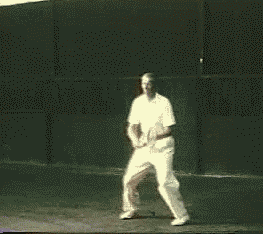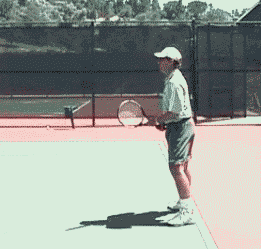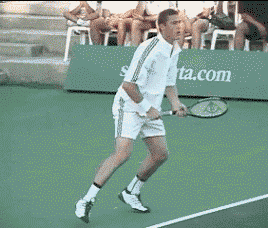|
TennisOne Lessons
First Things First Instructional Suiteby Jim McLennan
I am an on-court teaching pro, and have been teaching for the past 30 years. I learned the game from three wonderful men. I started at age 12 with Blackie Jones. In my little neighborhood there are five of us who grew up to become tennis teaching professionals, and this is a tribute to Blackie's love of the game, his insight, his warmth, his technical expertise and more.
Finally, in my 30's I worked with Don Kerr, a former badminton coach, and perhaps a tennis genius. His insights were into the service whip and to the nuances of gravity footwork. He seemed to tie many of the elements from Blackie and Tom together, and somehow knowing the original two gentlemen prepared me for the challenges of being a student of Don's. Over the years I have enjoyed working on my game, continuously tinkering, always willing to experiment. And I did so because of these men. As a teacher, my style, patterns of interaction, choice of words and examples have changed over the years as I learned more and as I experimented with various teaching strategies. A good friend and former business partner, Randy Becker, would often joke as he taught next to me, "Hey, its been 5 minutes over there, are you ever going to tell them anything?"
This style has grown yet again with the introduction by Townsend Gilbert to a teaching method known as "Exploration and Guided Discovery." In this model the student is not commanded to do it a certain way, nor criticized when their form deviates from a certain model, nor given a shopping list of criterion on a "correct" stroke. Rather the student is given a task, not told how to perform the task, perhaps there is a slight clue or demonstration from the teacher, but when the student explores various strategies to solve the task, they discover the solution and more or less own it. For example, if a player has an abbreviated follow-through and somewhat cramped style, the command model would note just that, and tell how to lengthen the follow-through. Yet somehow this cramped style may be only a symptom of an underlying cause, not necessarily remedied by commands on the follow though. In experiment and guided discovery, we might use a gentle forward and backward hip turn, ask the student to see how that "feels", and "experiment" with letting the arm go along for the ride. And then the task for the student becomes to exploring how that stroke feels, and hopefully discovering a pattern that either increases control, reduces effort, or whatever the student's projects are at that moment.
A model often used by tennis professionals to describe a progression of skills may actually highlight the problem. Using a continuum, it suggests that students arrive on court in a state of "unconscious incompetence." With instruction, generally using the critical and controlling command model, the student progresses to "conscious incompetence." Now the fun or pain begins as the teacher tries to move the student to "conscious competence" and then hopefully to one day being (much like the teacher) "unconsciously competent." But somehow the majority of the people I see at our club are stuck in the two areas described as conscious, and when conscious of either what they are doing right or wrong, they are residing in the cognitive area of their brain, and somehow the results just don't come for those people. They are stuck. So recently I have had two students arrive, one adult, one junior, both who came from command coaches. The young man tried so hard, swung and missed most of the time, when I asked him what was happening he said he was trying hard to remember all the things he had been told about the forehand, but somehow all that thinking only made things worse. And the adult had just come from a camp, learned way too much about what was wrong, and looked awkward from all the stuff she tried to correct. And in both cases these two were way too much in their head, lost in cognitive analysis, rather than looking out to the ball and letting it happen. Somehow I think this is a picture of how many of us try to learn the game. That is, we rely on thinking, analyzing and cognition, instead of feeling, rhythm and balance. And I now believe that focusing on the latter will speed nearly everyone's improvement. So how does this work its way into TennisONE?I am starting a "First Things First" instructional suite of lessons where there are very few words, and I apologize in advance to those of you who would prefer 675 words on the height of the backswing, or the position of the elbow at contact. That level of analysis is cognitive, and I do not see it assist the learning at my club. On the contrary, that place is more consistent with players who talk a good game than those who can feel how to play.So we will analyze the postures of various players at key moments of their strokes. Using the pro strokes gallery, you will view the stroke in its entirety but with reference to a certain posture, look or feel. The building blocks of this project begin with the hip turn, both back and forth, include posture, balance, position of the head, simplicity of the swing, the sound of the hit, and your overall estimation of effort. I guarantee that if you experiment with this your game might improve much more than it ever did if your coach was telling you 23 things to do in any given lesson. Less is more. Silence is golden. It's all in the feel.
Two minutes a day, on court or in the back yard, try and get a feel for these moves. They are the building blocks of a simple, economical, effective, and yes I can say this - a winning style. Tennis is all control and minimizing errors, and this system is proven.
And what works for the forehand will work for the backhand, as well as the serve and the volley. Come along for the ride, and look not for words and analysis but insight into the feel of the game. Your comments are welcome. Let us know what you think about Jim McLennan's article by emailing us here at TennisONE.
|
||||||||||||





